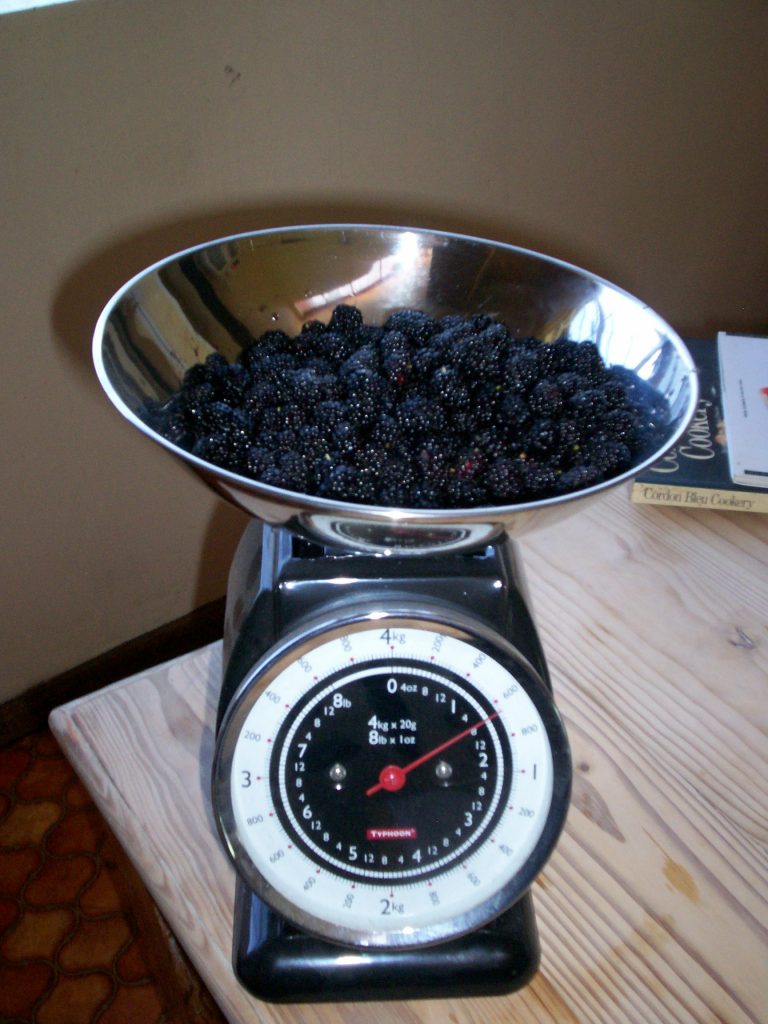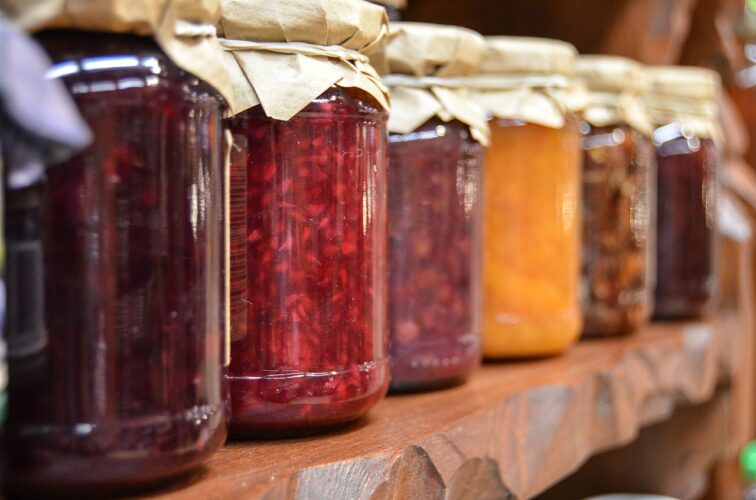With summer upon us, smallholders might have a fruit harvest too bountiful to eat ~ so why not make jam to use up the fruit and provide something sweet to get you through the winter months?
Jam can be made on a stove or in the microwave ~ both offering pros and cons. It is a time-consuming but highly rewarding process, delivering a final product to impress family and friends, give away as gifts or sell to make your plot profitable.
Thickening Your Jam
To make jam, pick your fruit on a dry day and make sure the fruit is under-ripe. Most fruits require the addition of pectin in some form ~ this acts as the thickening agent, giving your final product that jelly-like quality. It is a substance naturally found in fruit, although some fruits are higher in pectin than others. Pectin used to be available in powder form, but can now prove difficult to find. Under-ripe fruit has more pectin than ripe fruit which is why slightly under-ripe fruit is ideal for jam-making.
As some fruits have a higher pectin level than others so you can use these in your jam to thicken it ~ they include apples, cranberries and grapes. Gelatin works as well. Corn starch (Maizena) also works in very small amounts. Tapioca powder can be used at a measure of one to two tablespoons per one litre of prepared fruit.
This year, we tried something a bit different when making mulberry jam, which is known to be rather runny and difficult to set. Sliced two lemons, mixed them in with two kilos of mulberries and a kilo of sugar and left it all to soak overnight. Then cooked the fruit, lemons and all. The pectin from the lemons helped to thicken the jam, but when we took out the slices they had left a rather bitter taste. So we added another half a kilo of mulberries and about a quarter of a kilo of sugar and that helped to take away the bitterness.
The pith of citrus fruit contains high volumes of pectin. Rind is used as the thickening agent in marmalade but the pith can be used in jams as well. Remove the zest from the fruit, then peel the fruit and chop the peel. Add a little lemon juice to the peel and let stand for at least 30 minutes. Place the mixture in a pot, cover with water and bring to a boil. Let it cook for around 20 minutes. Strain and store for use. This homemade pectin can be stored for approximately one week in the fridge or it can be frozen. Use one cup of homemade pectin made from pith for each batch of jam.
Most recipes use fresh lemon juice ~ use one lemon per kilogram of fruit, including some of the pips.
For a coarse country-style jam plums and apricots do not need to be peeled, but most other fruits do. Raspberries, strawberries, blueberries, blackberries, mulberries and figs are all excellent fruit for jam-making. Peach jam is also a possibility but tends to be bland and it might need spicing up with ginger or other flavour-enhancers. Melons can be made into jam, also made tastier with the addition of ginger (and for many melon and ginger jam will remind them of boarding school).
Marmalade is traditionally made with citrus fruit and is a clear preserve containing shredded rind, although the term marmalade has been taken over to describe more modern culinary derivatives, such as onion marmalade, a popular condiment with strong cheeses.
Instructions For Stove-top Jam
To make the jam, generally speaking one should wash the fruit and cut out the pips. If you want the jam to be smooth, cut up the fruit into smaller pieces, otherwise simply halve or quarter them. Weigh the fruit. Weigh the sugar, usually allocating 750g – 1kg sugar per kilogram of fruit (sugar ratios may vary slightly according to the natural sugar content of the fruit).

If you are making jam in a pot on the stove, rub the bottom of the pot with butter and cook the fruit gently in a little water until it is tender. The water is only necessary to prevent the raw fruit from burning in the beginning, until it starts to release its own juice, so add as little as possible (because you will only have to boil it away anyway to get the jam to set).
Add the sugar gradually, stirring constantly with a wooden spoon, allowing each addition to dissolve before adding more. You’ll know the sugar has dissolved when you can’t feel grains of sugar scraping the bottom of the pot as you stir.

Allow the jam to simmer slowly for a couple of hours ~ a large pot full of fruit can take up to three hours. Some fruits result in a brown foam rising to the top of the mixture. Remove this as the jam cooks using a slotted spoon.
Stove-cooking renders the jam down, removing the fluid from the fruit. This also increases the chance of the mixture catching or burning. Stir constantly to ensure that it is not burning. The longer it cooks for the more moisture evaporates, making the danger of it catching and burning very much greater as the process progresses.
Instructions For Microwave Jam
Microwave-made jam is cooked quicker and the fruit retains its shape and colour better, but microwaving is only really suited to small quantities, for which the speed of a microwave jam is a distinct benefit. However, it can easily boil over so must be monitored closely.
In a large microwavable bowl, cook your chosen fruit on high for between seven and ten minutes or until soft. Add the sugar and stir well, microwaving for a further 20 minutes approximately. With all that sugar the mixture will boil over, so microwave for a minute or two at a time and stir in between.
Bottling Your Finished Product
To test if the jam is done ~ for both cooking methods ~ put a little on a cold saucer. If, when cool, it jellies or it wrinkles when you push it with your thumbnail, the jam is ready for pouring into the bottles. Jam takes a long time to cool and set properly, so the best you can hope for of the drip on your saucer is that it doesn’t run thinly. Don’t expect the few drops on your plate to set instantly to the consistency you’d like on your toast.
Allow the jam to cool a little slightly before pouring into hot, dry, sterile jars. If the fruit rises in the jars, the jam is too hot to bottle.
Jam must be put into sterilized jars once cooked. Jars can be sterilized by washing the bottles and lids thoroughly.
Proper preserving jars with single-use metal lids and screw rings are best (called Consol jars in South Africa but commonly referred to as Mason jars in overseas recipes) but clean mayonnaise or gherkin jars can also be used. Use only glass jars.

During washing, ensure you have removed any residual smell or flavour of its previous contents. Place the jars ~ without the lids ~ in the microwave with about 3cm of water in each. Microwave on full power for five minutes. Wearing oven gloves or holding a towel, slosh the boiling water around the jar and discard. Dry the jars by standing them upside down in a warm oven ~ do not use a cloth to dry as this will just re-contaminate the glass. Mildew might occur on the jam if the jars are not dry. Boil the lids in water on the stove ~ even new lids.
Screw the lids on loosely while the jam is still warm, and tighten as much as you can with one hand while pressing down on the metal lid to “pop” it downwards. As the jam cools and contracts a small vacuum will form in the void above the jam, depriving any bacteria remaining of oxygen and preventing mould from forming.
For diabetics, slimmers and people struggling with yeast imbalances, you can make jam with fructose or Xylitol, both of which are available at health shops and supermarkets. These sweeteners have as much as three times the sweetening power of sugar, so use 350-500g per kilo of fruit.

